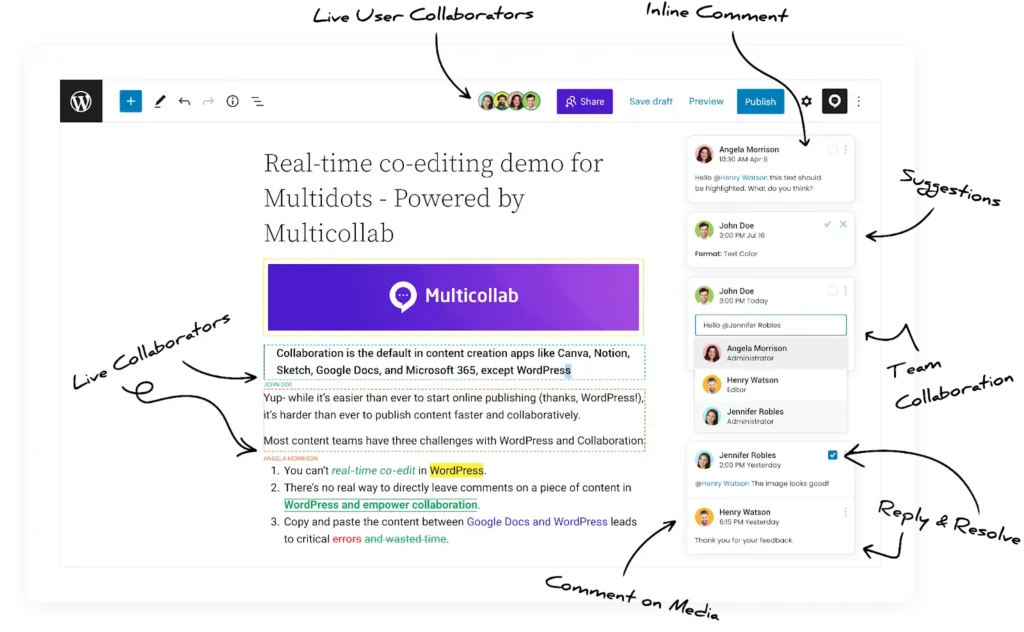Table of Contents
Managing global content teams can often feel like you’re trying to juggle multiple tasks at once, each with its own set of time zones, languages, and priorities. It’s easy for things to go off track, and suddenly, deadlines are missed, messages get lost in translation, and everything starts to feel a bit chaotic. Whether you’re a small team or a large one, these global content collaboration challenges can feel overwhelming.
This is where tools like Multicollab come in to save the day. They help take the stress out of the process by bringing everything into one place, making it easy for your team to collaborate no matter where they are. With features like real-time editing, inline comments, and multilingual support, Multicollab makes working together feel as simple as if you were all in the same room.
So, no matter where your team members are located or how big your editorial team is, let’s explore how to align your efforts and create content that resonates globally.
What are the common challenges in global content collaboration
Global teams collaborating on content across the globe face several unique hurdles that slow down productivity, weaken brand messaging, and create inefficiencies that affect everyone involved. Let’s take a look at some of the most common roadblocks that editorial and publishing teams encounter:
Time zone differences
Working across time zones when team members are spread out across the globe often leads to delayed responses and approvals. For example, a regional team may wrap up a campaign draft but have to wait for late-night approvals from HQ.
This delay can create bottlenecks that push deadlines further and further back, killing momentum and throwing off the entire content creation process.
Multilingual and multi-regional inconsistencies
Brand consistency is hard enough to maintain in one language; add multiple languages and regions, and the task becomes even trickier. Differences in tone, phrasing, and even cultural nuances can lead to mixed messaging.
Translating content without aligning on the intended message or tone of voice can confuse your audience and hurt your brand’s reputation. It’s a balancing act to make sure that content feels authentic and resonates in every market, while staying true to the core brand identity.

Communication breakdowns
In large teams, feedback often gets scattered across various platforms, making it hard to keep track of everything. Relying on multiple email threads, messaging apps, and documents for feedback can lead to missed updates, redundant work, or conflicting input. This kind of breakdown makes it easy for key points to slip through the cracks, stalling progress and wasting time.
Workflow fragmentation
When different teams operate in silos, content workflows can become fragmented and disjointed. Regional teams may run their own campaigns without fully syncing with the central team, leading to misaligned objectives, duplicated efforts, and wasted resources. This disconnect means that both local and global campaigns suffer, which ultimately impacts the overall success of your content strategy.
The good news? These challenges don’t have to be roadblocks. By addressing them directly, global editorial teams can streamline their workflows, improve collaboration, and boost productivity. The first step toward solving these problems? Implementing the right tools and strategies like Multicollab to connect the dots and keep everything running smoothly.
How to overcome global collaboration challenges with Multicollab
As we’ve seen, managing global content teams comes with its own set of hurdles. But with the right tools, these challenges can be transformed into opportunities for greater efficiency and smoother workflows. Multicollab is designed to address these pain points head-on, enabling teams to collaborate effortlessly across regions. Here’s how:

Real-time editing across regions
Feature: Collaborators can edit and review content simultaneously, regardless of location.
Time zone differences don’t have to be a bottleneck anymore. Whether it’s late in the evening in one region or early morning in another, team members can contribute to the same document at the same time. Real-time editing keeps everyone on the same page and prevents long waiting periods for approvals, making it easier to maintain momentum and meet deadlines.
Inline comments for precise feedback
Feature: Add comments directly within the content for clear, context-driven feedback.
This feature eliminates ambiguity, ensuring that feedback is always relevant and actionable. Instead of getting lost in long email threads or scattered notes, editors can leave comments exactly where changes are needed, making it easy for the team to address issues without wasting time trying to figure out what’s been said. This clarity helps regional teams make targeted adjustments, ensuring content stays on track.

Customizable permissions for team alignment
Feature: Assign specific roles and access based on team needs or regional requirements.
Multicollab’s permission system allows you to balance open collaboration with content security. You can ensure that each team member only has access to the parts of the project that are relevant to their role. This eliminates the risk of unauthorized changes or confusion, while allowing for efficient collaboration within the scope of each team’s responsibilities.
Seamless integration with WordPress
Feature: Multicollab works directly within the WordPress environment, so teams don’t have to jump between tools.
One of the biggest challenges with new collaboration tools is the disruption they can cause in existing workflows. With Multicollab’s WordPress integration, global teams can continue working within the platform they’re familiar with, ensuring a smoother adoption process and minimizing workflow interruptions. This seamless connection streamlines the entire content creation and approval process, from draft to publication.
What are the practical steps to improve global collaboration
Improving global content collaboration doesn’t happen overnight—it requires intentional action and ongoing evaluation. By following these practical steps, you can streamline your processes, reduce inefficiencies, and ensure that your teams work together more effectively. Let’s break it down:
Step 1: Audit current processes
The first step to improving collaboration is identifying where your current workflows and communication strategies are falling short. Take a deep dive into how your teams are managing tasks, sharing feedback, and moving content from draft to publication.
Are there long delays due to time zone differences? Is feedback scattered across multiple platforms? Are teams working in silos?
Conducting an audit will help pinpoint the inefficiencies that need to be addressed so that you can focus on fixing the right issues.
Step 2: Choose the right collaboration tool
Once you’ve identified your team’s pain points, it’s time to choose a tool that can help address them. Consider options like Multicollab for its ability to streamline workflows, facilitate real-time editing, and centralize feedback all within WordPress.
When evaluating collaboration tools, think about your team’s specific needs—do you need real-time collaboration? Multilingual support? Customizable permissions? A good tool should integrate smoothly into your existing workflow, offer the features necessary to tackle your challenges, and scale as your team grows.
Step 3: Train teams on collaboration best practices
Tools alone won’t solve collaboration challenges. Teams need to be trained on how to use them effectively. Host workshops or training sessions to ensure that everyone is on the same page regarding best practices for collaboration.
For instance, teach team members how to leave actionable inline comments, how to update content in real time, and how to follow your established feedback process. Training ensures that your team fully leverages the tool’s capabilities and works cohesively across regions, even when working asynchronously.
Step 4: Monitor and optimize
Finally, continuous improvement is key. Regularly monitor collaboration metrics like response times, task completion rates, and overall workflow efficiency. Use these insights to spot areas that still need improvement and make necessary adjustments.
For example, if feedback is still being delayed despite implementing real-time editing, it might indicate that further process tweaks or additional training are needed. By continuously optimizing your collaboration processes, you’ll ensure that your global content team remains aligned, efficient, and productive.
How to balance regional autonomy with global consistency
Balancing regional autonomy with global consistency is a major challenge in global content collaboration. While local teams should be empowered to adapt content to fit cultural nuances and resonate with their specific audiences, it’s equally important to maintain a unified brand voice across regions. This balance ensures that content feels authentic and relevant while adhering to global brand standards.
Tools like Multicollab make this balance easier by enabling real-time collaboration, centralized feedback, and the enforcement of brand guidelines. Local teams can make adjustments to content, but the central team retains oversight to ensure that the messaging remains consistent globally. This approach allows regional teams the creative freedom to adapt content for their markets while maintaining the integrity and consistency of the brand across all regions.
Streamline your global content collaboration today
Time zone conflicts often lead to delayed approvals, multilingual inconsistencies can dilute your brand messaging, and disjointed workflows make it difficult to maintain alignment across regions. These hurdles can slow down content production, hinder collaboration, and create inefficiencies that affect overall productivity.
Multicollab is designed to address these challenges head-on. With features like real-time editing, inline comments, multilingual support, and customizable permissions, Multicollab helps streamline collaboration, ensures content consistency, and keeps teams aligned, regardless of their location. By empowering local teams with the flexibility they need while maintaining global standards, Multicollab makes global content collaboration smoother and more effective.
Here’s a review for you to assess how Multicollab can transform the way your teams work together.
Ready to streamline your global content collaboration? If yes, check out Multicollab’s latest pricing.








